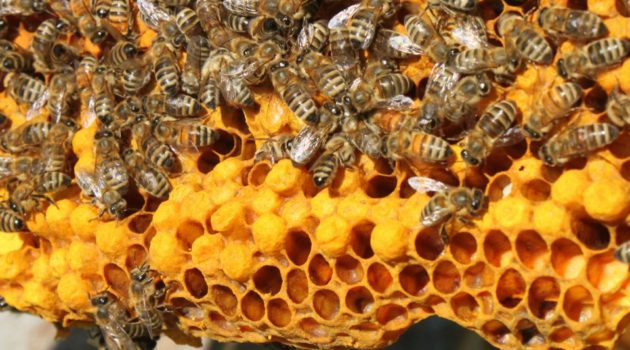In the case of the honeybee however the breeder is confronted not with isolated individuals but with a society, or to put it more scientifically, with a super-organism, an extraordinarily well regulated and well ordered system, and a structure whose individual parts operate in perfect harmony. Moreover this social organism is in itself immortal, by which I mean that a colony of bees never dies of old age but only because of some misadventure due to external causes.
What are my bees?
This is the most popular question I am asked, and I find it impossible to respond in the way that most people are used to hearing. I might as well say my bees are vermont bees, or simply, my bees, neither of which is descriptive enough to relate pertinent qualities.
My queen lineages are roughly 1/3 carniolan based, 1/3 russian based, 1/3 buckfast-ish / italian based.
Qualities of the hive follow the queens lineage more so than the drones (61%) and so my bees attributes will vary on the lineage I breed from.
A more accurate accounting perhaps derives from describing breeding goals, selection criteria and the conditions the bees live in, all of which influence which bees survive and thrive.
I can say that my gene pool is diverse as I continue to bring in bees (from other apiaries) to test and add to my family list, this year to include 14 lineages. The queens I sell are daughters of those time tested and reliable lineages in whom consistent survival and production the norm not the exception (roughly ¼ of total). Not all of my lineages produce such consistency (evidenced in progeny survival). I work with some queen lines whose production surpasses all others, but whose mite resistance is obviously lacking as gauged by the low % making it through the full season, before crashing from mite loads. I continue to propagate the best of these bees with the belief that in isolation, I may be able to cross these with drones from mite resistant stock.I have acquired a location that may fit these needs and am making crosses there this season (2015)
Simplified Breeding goals:
The bees must winter where I live (zone 5). I don’t migrate to the south for winter
Bees must thrive without treatments of any kind.
Selection criteria: Breeders are:
-
-
-
-
- – the colonies (same queen) who survive 2 winters
- and whom have made surplus honey crops without showing any disease of brood or bees,
- nor suffered from excess mite loads. (it should be said I dont count mites but rather gauge performance based on the large scale I.e the overall hive activity. More on this)
- Docility
- Continuity of lineage. Able to supercede and self propagate.
- Appropriate and timely allocation of winter stores.
-
-
-
It should first be stated that although my goals with my bees include combination-breeding, I have not as yet, in the strictest sense bred, but have only selected. The difference between the two is crucial. Breeding involves control over both the queen selection and the drones she mates with. This is accomplished by Artificial insemination, isolated mating apiaries, drone saturation and some other less known methods.
Selection is part of breeding, in other words assessing and evaluating the outcomes of various crosses and choosing the colonies to further propagate. So far in my first 5 years, I have only selected the outcomes of open matings, which by their nature afford no control over the drones the queen mates with. Progress in this way is very slow, but not impossible with regards to attaining breeding goals. In fact, Ive been increasingly encouraged by the results, as relates to disease resistance, mite resistance, and performance. On the other hand, in some cases, I have observed a lessening of valuable traits in some queen lineages after a few generations, exhibited in decreased vitality, production, and increased disease in the progeny.

